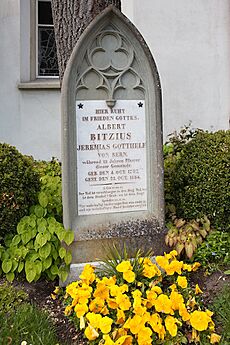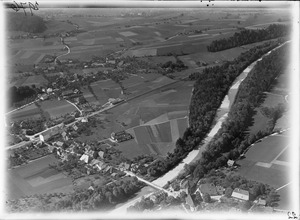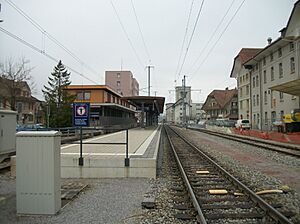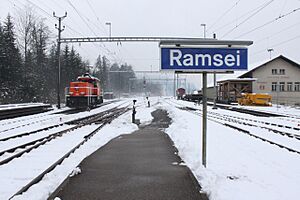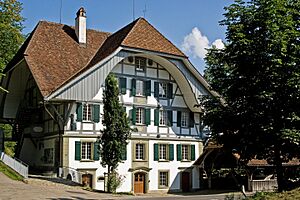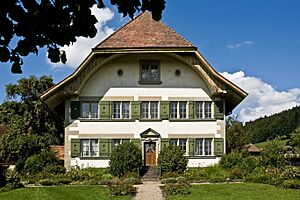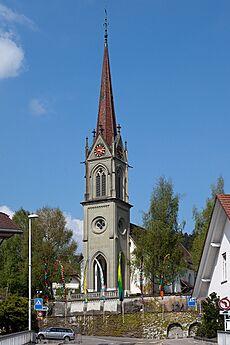Lützelflüh facts for kids
Quick facts for kids
Lützelflüh
|
||
|---|---|---|

The Kulturmühle in Lützelflüh village
|
||
|
||
| Country | Switzerland | |
| Canton | Bern | |
| District | Emmental | |
| Area | ||
| • Total | 26.87 km2 (10.37 sq mi) | |
| Elevation | 585 m (1,919 ft) | |
| Population
(Dec 2020 )
|
||
| • Total | 4,211 | |
| • Density | 156.72/km2 (405.90/sq mi) | |
| Postal code |
3432
|
|
| Surrounded by | Hasle bei Burgdorf, Krauchthal, Landiswil, Oberburg, Rüderswil, Rüegsau, Sumiswald, Trachselwald, Walkringen | |
Lützelflüh is a lovely town in Switzerland. It is located in the Emmental region of the Bern canton. Lützelflüh is known for its beautiful scenery and interesting history.
Contents
A Glimpse into Lützelflüh's Past
Lützelflüh was first mentioned in official records in 1225. It was called Lucelfluo back then. People likely lived in this area even during the Roman times. However, only a few Roman coins have been found near the old Brandis Castle.
During the High Middle Ages, around 1230, Brandis Castle was built. This castle became very important for the area. The town of Lützelflüh grew around the homes of local noble families.
In 1450, the Brandis Castle was sold to the powerful city of Bern. Over time, it changed hands several times. Finally, in 1607, it became fully owned by the city of Bern. Lützelflüh then became a bailiwick of Bern. This meant it was an area ruled by an official appointed by Bern.
Sadly, on April 14, 1798, Brandis Castle burned down. This fire marked the end of the bailiwick system. Lützelflüh then became part of the Trachselwald district.
Growth and Industry
In 1881, the Emmental railroad was built through the village. This train line helped new businesses and factories come to Lützelflüh. A few years later, in 1886, the Emme river was made straighter. This project helped prevent floods and created more farmland.
The railroad and the new road through the valley helped Lützelflüh become a local center for industry. An oat and barley mill opened in 1898. Soon after, metal and flooring factories also started operating. Several companies that exported cheese also set up shop here.
Famous Residents
In 1831, a famous Swiss writer named Albert Bitzius moved to Lützelflüh. He is much better known by his pen name, Jeremias Gotthelf. He started as an assistant pastor and later became the main priest. He lived the rest of his life in Lützelflüh. You can find his grave in the local cemetery. There is also a small museum dedicated to him in the village.
In 1879, Lützelflüh and the nearby village of Goldbach built a secondary school together. This showed their commitment to education.
Exploring Lützelflüh's Geography
Lützelflüh is located in the lower part of the Emmental valley. It sits right on the Emme River, between the towns of Langnau and Burgdorf. The Emme River actually divides the main village into two parts. The older part is on the right side of the river, and the newer part is on the left.
The municipality of Lützelflüh also includes other smaller villages and hamlets. These include Ramsei, Grünenmatt, and parts of Trachselwald, Goldbach, and Ranflüh. There are also tiny settlements like Waldhus and Flüele. Two separate areas, Oberried and Lauterbach, also belong to Lützelflüh.
Most of Lützelflüh's land is used for farming (about 65%). A good portion (about 25%) is covered by forests. The rest of the land is used for buildings, roads, and rivers.
Lützelflüh's Coat of Arms
The official coat of arms for Lützelflüh is quite descriptive. It shows a red background with a wavy silver stripe across it. At the top, there are six green fir trees. Each tree grows from a small silver hill.
People and Population
Lützelflüh has a population of about 4,052 people (as of December 2012). A small part of the population (around 5%) are foreign nationals. Most people in Lützelflüh speak German as their first language (about 96%). Smaller groups speak Italian or Albanian.
In 2013, the population was almost evenly split between males (48.8%) and females (51.2%). About 21.6% of the population are children and teenagers (under 19 years old). Adults (20-64 years old) make up about 59.9%, and seniors (over 64 years old) are about 18.5%.
Many people who live in Lützelflüh were also born there or in the same canton. About 35% of the population in 2000 were born in Lützelflüh itself.
The number of people living in Lützelflüh has changed over the years. You can see how the population has grown and shrunk in the chart below:

Lützelflüh's Economy and Jobs
In 2011, Lützelflüh had a low unemployment rate of 2.24%. Many people work in the town.
- The primary sector (like farming) employed 366 people.
- The secondary sector (like manufacturing and construction) employed 572 people.
- The tertiary sector (like shops, hotels, and healthcare) employed 736 people.
About 43.5% of the workers in Lützelflüh are female. Many people who live in Lützelflüh also work there. However, more people travel out of Lützelflüh for work than those who come into the town for work. About 13% of workers use public transportation, while over 50% use a private car to get to work.
Important Buildings and Sights
Lützelflüh has some special buildings that are important to Switzerland's history.
- The old mill at Mühlegasse 29 is now called the Kulturmühle. It is used for concerts and events.
- The rectory (the priest's house) at Rainbergliweg 2 is also a very important historical site.
The entire villages of Lützelflüh and Trachselwald are part of the Inventory of Swiss Heritage Sites. This means they are protected for their historical value.
Main Attractions
- The Church of Lützelflüh was built in 1505. It was updated in 1962. The graves of three famous writers from Lützelflüh are located here: Jeremias Gotthelf, Simon Gfeller, and Emanuel Friedli.
- The Gotthelf-Museum is near the church. It is named after the famous writer Jeremias Gotthelf. It tells the story of his life and work.
Religion in Lützelflüh
According to the 2000 census, most people in Lützelflüh (about 82%) belong to the Swiss Reformed Church. About 5.4% are Roman Catholic. There are also smaller groups of people who belong to other Christian churches or are Muslim, Hindu, or Buddhist. About 3.8% of the population do not belong to any church.
Education and Schools
In Lützelflüh, many people have finished their secondary education. About 15% have also completed higher education, like university.
The school system in the Canton of Bern works like this:
- One year of optional Kindergarten.
- Six years of Primary school.
- Three years of mandatory lower Secondary school. Students are grouped by their abilities.
- After lower Secondary, students can continue their education or start an apprenticeship (on-the-job training).
In the 2012-2013 school year, 444 students attended schools in Lützelflüh. This included students in kindergarten, primary school, and lower secondary school. Some students were from other countries or spoke a different language at home.
Tourism in Lützelflüh
Tourism in Lützelflüh is not huge, but it is important. There are several inns in the area where visitors can stay. These inns are typical for the region. It is also possible to stay and vacation on local farms. This offers a unique experience for visitors.
See also
 In Spanish: Lützelflüh para niños
In Spanish: Lützelflüh para niños






